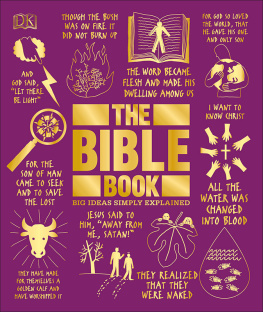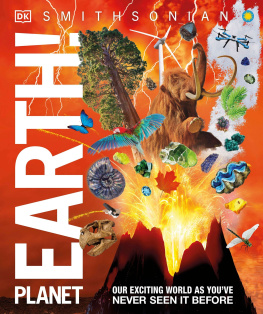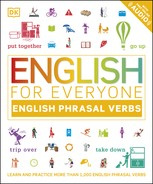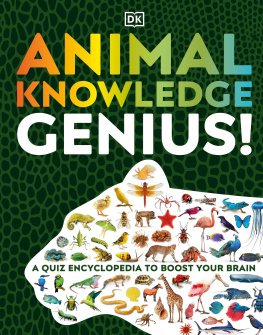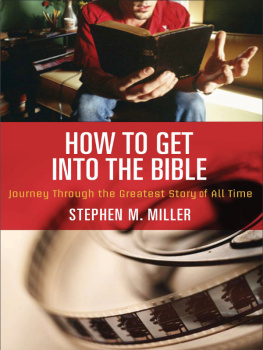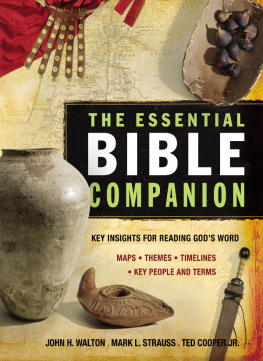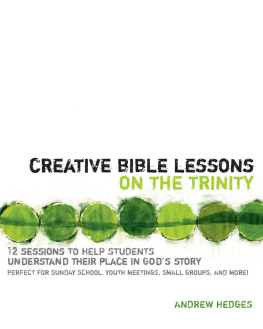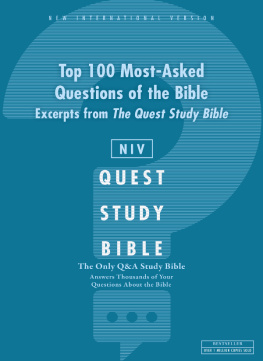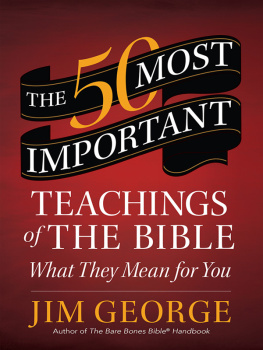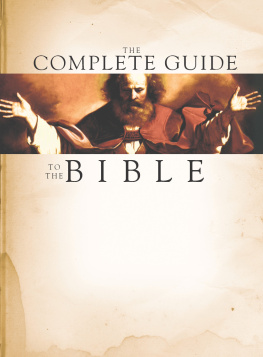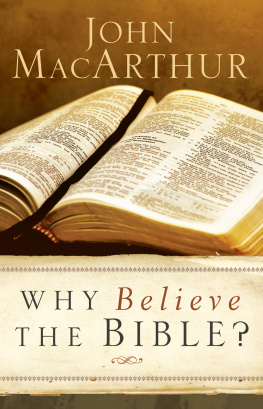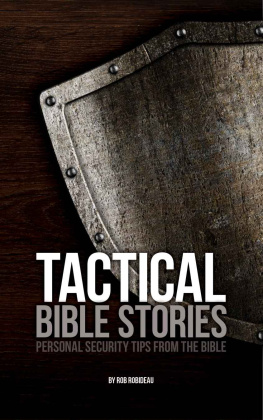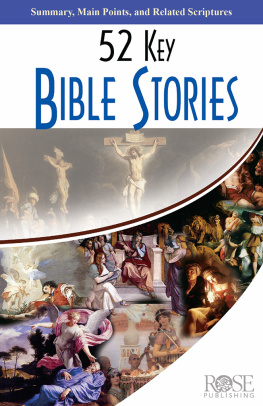CONTRIBUTORS
Tammi J. Schneider, phd, Consultant
Dr Tammi J. Schneider is a Professor of Religion at Claremont Graduate University, having received a doctorate in Ancient History from the University of Pennsylvania. Her books include: Sarah: Mother of Nations; Judges; Mothers of Promise: Women in the Book of Genesis; and An Introduction to Ancient Mesopotamian Religion. She excavates in Israel.
Shelley L. Birdsong, phd
Dr Shelley L. Birdsong is a member of the Religious Studies faculty at North Central College, Naperville, Illinois. Her interests range from topics such as women in the Bible to specific text critical issues in ancient Jeremiah manuscripts.
Andrew Kerr-Jarrett
Andrew Kerr-Jarrett read English at Trinity College, Cambridge. He is a writer and editor of more than 25 years standing. He facilitates seminars and workshops at the Mount Street Jesuit Centre in London, UK.
Rev Dr Andrew Stobart
Rev Dr Andrew Stobart is a Methodist Minister in Darlington, UK, and commissioning editor of Holiness, an online theological journal published by Wesley House, Cambridge. He studied theology at the London School of Theology, Aberdeen University, and Durham University, and has contributed to a number of reference works, including DKs The Illustrated Bible and The Religions Book.
Benjamin Phillips, phd, Consultant and Contributor
Dr Benjamin Phillips is Associate Dean and Associate Professor of Systematic Theology at Southwestern Baptist Theological Seminarys Houston Campus, where he teaches courses in Christian doctrine and preaching. He is also Director of Southwesterns Darrington Extension, which offers a bachelors degree in Biblical Studies to offenders in the Texas prison system.
Guy Croton
Guy Croton is an author and editor who has written, co-written or edited books and articles on a variety of subjects in a career spanning more than 30 years. A Christian Humanist by religious and moral inclination, he studied theology and biblical history as part of his degree at the University of Sussex.
Nicholaus Pumphrey, phd
Dr Nicholaus Pumphrey is the Assistant Professor of Religious Studies and Curator of the Quayle Bible Collection at Baker University, Baldwin City, Kansas. He specializes in Biblical Studies, Ancient Near Eastern history and literature, and Islamic Studies. He is currently a senior staff member on the Tel Akko Total Archaeology Project in Akko, Israel.

INTRODUCTION
The Bible is the worlds most famous book and a keystone text of Western civilization. It has been translated into more languages than any other text in history, and it remains the most prolifically published book since the invention of the printing press. Christians worldwide look to it as sacred scripture the written word of God, given by divine inspiration. It has influenced art, language, music, and literature for more than 2,000 years: in fact, the history of Western art cannot be fully understood without at least some knowledge of the Bible.
The Bibles teachings have also shaped social, economic, and political developments, contributing to Western civilizations emphasis on the value of the individual rather than the state. It is the subject of academic study by believers and sceptics, and its words are the source of comfort and challenge from pulpits on every continent.
Moved by God
The Bible is a collection of 66 books, written by some 40 authors, living on three continents (Africa, Asia, and Europe), and over 1,400 years (c.1200 BCE c.100 CE ). These authors understood themselves to be moved by God to write the word of the Lord. By the first century BCE , most Jews had come to recognize the 39 books of the Hebrew Bible, written in Hebrew and Aramaic, as Gods written word the scriptures (from scriptura, Latin for writings). Later, the Christian churches of the first and second centuries CE similarly acknowledged the four Gospels and a range of apostolic letters, written in Greek, as the word of God, alongside the earlier Hebrew scriptures.
These texts communicate to the modern reader through a system of transmission and translation that began with the ancient Israelites. As early as the third century CE , scholars were comparing copies and translations of the Hebrew Bible. This process continues among scholars today, who collect and compare newly discovered copies of biblical texts in order to establish a critical text from which translations are then made.
The most famous English translation is the Authorized Version, also called the King James Version, published in 1611. The Bible Book refers to the New International Version, an English translation from 1978 that aims to make the text understandable to modern readers.
We did not follow cleverly devised stories but we were eyewitnesses of His majesty.
2 Peter 1:16
Book of books
The 66 books of the Bible are divided into two major sections. The first in the Christian Bible is the Old Testament (the Hebrew scriptures of Judaism, known as the Tanakh), comprising 39 books, which were written for the ancient nation of Israel. It begins with the five books of the Law (the Torah: Genesis to Deuteronomy), and proceeds through the Historical Books (Joshua to Esther). Although these books are arranged in roughly chronological order, the writing of the books occurred at various points along the timeline. For example, Psalms was probably written quite early, while Isaiah and Amos were contemporaries. The third group of books are the Poetical Books (Job to Song of Solomon), followed by the Major Prophets (meaning large books: Isaiah to Daniel) and the Minor Prophets (meaning small books: Hosea to Malachi). These books are considered sacred texts by both Christians and Jews.
A small set of books, often referred to as the Apocrypha (from the Latin apocryphus, meaning hidden) are considered by Roman Catholic and Eastern Orthodox Christians to be part of the Old Testament. These seven books, plus additions to the books of Daniel and Esther, were primarily written in Greek from 400300 BCE . They are not regarded as scripture by either Protestant Christians or Jews, who argue that these books deny that there was any prophetic word from God (the characteristic of scripture) during the period in which they were written.
The New Testament comprises the Christian scriptures, 27 books that are accepted by all Christian denominations as the complete list of New Testament books. The title New Testament arises from the prophecy of a new covenant (testament) that God would give to His people (Jeremiah 31:3134). Most of the 27 books of the New Testament were written in the first century CE by Jesuss apostles, although some books, such as Hebrews, are anonymous. They were written for Christian churches and individuals scattered across the eastern half of the Roman Empire. The first group of books are the four Gospels (Matthew, Mark, Luke, and John), which present the life and ministry of Jesus Christ as the fulfilment of the Old Testament prophecies heralding a saviour for Israel and the nations.
The book of Acts describes the spread of the message about Jesus in the 30 years after His death, resurrection, and ascension into heaven, while the New Testament letters, known as epistles, are divided into the Pauline Epistles (Romans to Philemon) and the General Epistles (Hebrews to Jude). The final New Testament text is the book of Revelation.

